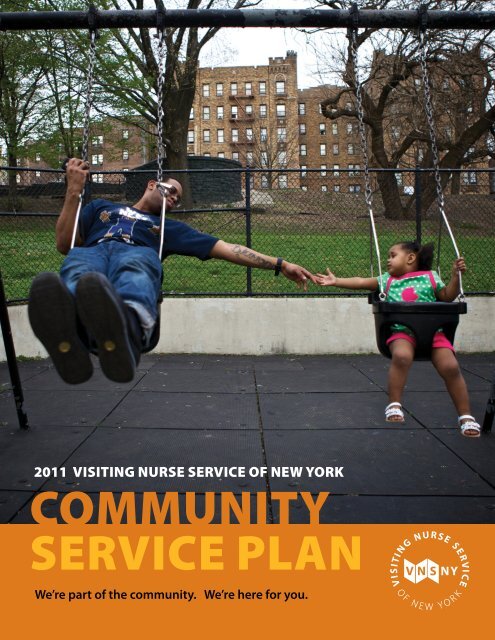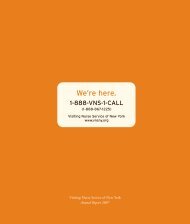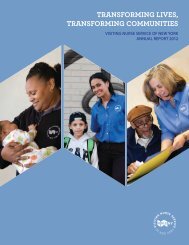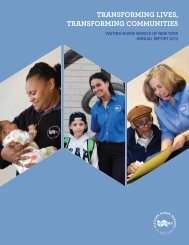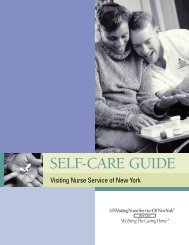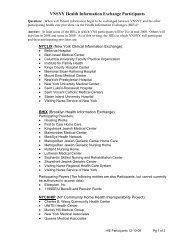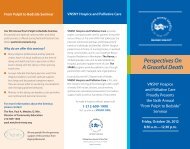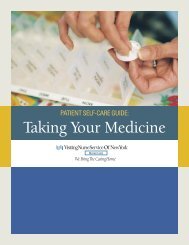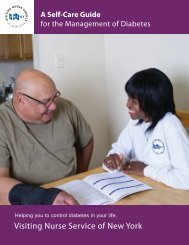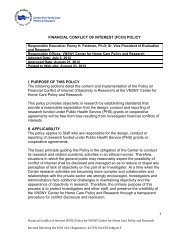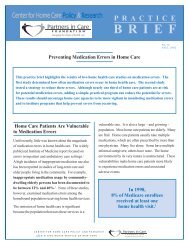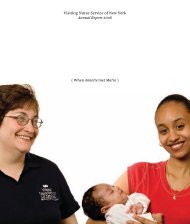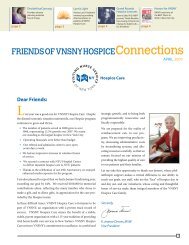COMMUNITY ServICe plaN - Visiting Nurse Service of New York
COMMUNITY ServICe plaN - Visiting Nurse Service of New York
COMMUNITY ServICe plaN - Visiting Nurse Service of New York
Create successful ePaper yourself
Turn your PDF publications into a flip-book with our unique Google optimized e-Paper software.
CHARITABLE CAREProviding Home Health CareRegardless <strong>of</strong> a Person’s Ability to PayFor 118 years, we have<strong>of</strong>fered our services tothose in need <strong>of</strong> homehealth care, regardless<strong>of</strong> their ability to pay.2VNSNY is committed to providingcare to the most vulnerable <strong>New</strong> <strong>York</strong>ers,in the most underserved communities.For 118 years, we have <strong>of</strong>fered our servicesto those in need <strong>of</strong> home healthcare, regardless <strong>of</strong> their ability to pay.“Our mission is to serve the poor,” saysChristopher Oates, Manager <strong>of</strong> CharitableCare. “VNSNY’s Charitable Care Programallows social workers and nurse casemanagers to fulfill this mission. Theytake the baton from the hospital or aclinical setting, and treat people in theircommunities. And, hopefully, our preventativeand treatment measures keepthese patients out <strong>of</strong> emergency rooms.”In fulfilling our mission and our obligationas a not-for-pr<strong>of</strong>it organization,VNSNY provides free home care servicesto the undocumented, uninsured, andunderinsured. In a well-structured program,VNSNY does outreach to hospitalsand clinics in the metropolitan area—the five boroughs <strong>of</strong> <strong>New</strong> <strong>York</strong> City andNassau and Westchester Counties—encouraging staff to refer likely applicantswho need free services basedon their income level. “I don’t knowany other organization, particularly inhome care, that is being so proactive,”Christopher says. “As a former dischargeplanner and social worker, I would hearabout charity care opportunities by word<strong>of</strong> mouth, mostly other social workerstalking. What we do at VNSNY is tellanyone who might need us: ‘This is a resourcefor your tool bag, and you’ll findit very helpful. And they listen.’”
VNSNY Charitable Care In ActionVNSNY CharitableCare provides aid forthousands <strong>of</strong> peoplein need. Here is one<strong>of</strong> their stories:“W e recently had a patient whohad been in a car accident,” says JoannaValentine, RN, Lead Home Care Consultantat the Hospital for Special Surgery.“He had pretty serious injuries—multiplefractures and problems with his spine.When it was time for him to begin rehab,he told us that he couldn’t afford it. He saidhe was unemployed, living <strong>of</strong>f credit cards,overwhelmed with debt, and his accidenthad just added to his financial burden.“With injuries like his, a relatively shortperiod <strong>of</strong> rehab makes the differencebetween a full recovery and life-longphysical limitations, resulting in years<strong>of</strong> costly health care treatments. Withrehab, he would be able to get better, toeventually get back to work, get himselfout <strong>of</strong> debt. Without it, he would be stuckwith very limited mobility for the rest <strong>of</strong>his life, which could, over time, becomea financial burden both for him and onthe health care system as a whole.“Luckily, he qualified for VNSNY’sCharitable Care, and we were able to gethim back into his home and on the roadto recovery. In addition to regular visitsfrom a nurse and a physical therapist, hehad a home health aide help him withday-to-day activities—living in a fourthfloor walk-up, without the aide, thingslike going to the pharmacy and thegrocery store would be nearly impossible.We were able to help him get throughthe most difficult time, both medicallyand logistically, and he’s getting better.”3
VNSNY VOLUNTEER PROGRAMHelping Us Help Patientsin Their CommunitiesLast year, our volunteershad an impact on almost6,000 patients.Photo: VNSNY volunteer LeslieSchatzer fits wigs for VNSNYcancer patients.During 2010, VNSNY volunteersmade an impact on almost 6,000 patients,including some <strong>of</strong> the most vulnerablein our service area: children and familiesin need and individuals suffering frommental illness. VNSNY volunteers domany important things for the organization,including raising funds and providing“extras,” such as toys for children from lowincomefamilies, layettes to young familiesjust starting out, enriching activities likemusic and art therapy or tabletop gardeningto seniors at adult day care centers, andin-kind services, including apartmentfurnishings, to new mothers moving out<strong>of</strong> shelters. VNSNY volunteers are madeup <strong>of</strong> high school and college students,working and nonworking adults andretirees, and corporate employees. Volunteersrange in age from 14 to 92 years old,a quarter <strong>of</strong> them teenagers and a quarter65 or older. About 60 percent are female.Some VNSNY volunteers donate their timeand services because they just want to giveback to their communities. Jermaine Evans,a Bronx Fatherhood Program volunteerwho mentors new fathers, says volunteeringfor VNSNY “can not only benefit you andimprove your outlook on life, but it can makeyou a productive, active part <strong>of</strong> society.”Leslie Schatzer, for instance, volunteers fittingwigs for VNSNY cancer patients. “Theystill go out — shopping and doing things,”Leslie says, “and they still like looking good.”As to helping them look good, “I do love it.I really love it.”In 2010, the dollar value <strong>of</strong> the time volunteersdonated to VNSNY was valued at$1.8 million. Really, though, the work <strong>of</strong>VNSNY volunteers, who go out <strong>of</strong> theirway to keep patients safe and healthy intheir communities, is priceless.4
HOSPICE AND PALLIATIVE CARE SERVICESProviding Support and Comfortto People with Terminal IllnessesOur goal is to promotecomfort and quality<strong>of</strong> life by providingthe best medical,nursing, emotional,and spiritual care.VNSNY Hospice and Palliative Care is aprogram <strong>of</strong> hope and humanity, designedspecifically to meet the needs <strong>of</strong> peoplewith terminal illnesses, and their families.VNSNY delivers this specialized care ina number <strong>of</strong> settings–in the home, in anursing home, at our Shirley Goodmanand Himan Brown Residence, and at theVNSNY Haven Hospice Specialty CareUnit. Our staff includes physicians, nurses,social workers, spiritual care counselors,dieticians, bereavement counselors,home health aides, a massage therapist,and volunteers.Our goal is to promote comfort and quality<strong>of</strong> life by providing the best medical, nursing,emotional, and spiritual care. VNSNYwelcomes contributions in support <strong>of</strong> ourimportant work. Philanthropy <strong>of</strong>ten makesa critical difference in our ability to servepatients at the end <strong>of</strong> life and their families.Donors help to sustain our programs as wellas to undertake new initiatives that expandour reach to those most in need.VNSNY Hospice and Palliative Care is thelargest program <strong>of</strong> its kind in the <strong>New</strong> <strong>York</strong>metropolitan area. On any given day, wehave more than 700 Hospice and PalliativeCare patients in our care.5
<strong>COMMUNITY</strong> MENTAL HEALTH SERVICESProviding Mental Health <strong>Service</strong>sso No One Falls Through the CracksVNSNY’s CommunityMental Health programsserve the severely andpersistently mentally ill,provide geriatric mentalhealth case management,and <strong>of</strong>fer mental healthcounseling to childrenand families.VNSNY <strong>of</strong>fers a wide range <strong>of</strong> city, state,and charitable care funded CommunityMental Health <strong>Service</strong>s programs thatserve the severely and persistently mentallyill, provide geriatric mental health casemanagement, and <strong>of</strong>fer mental healthcounseling to children and families.Our FRIENDS program, for instance,provides comprehensive mental healthand social support to high-risk emotionallydisturbed children in the Mott Haven section<strong>of</strong> the Bronx. The goal is to stabilizechallenging behaviors while ensuringgreater academic and social achievement.The FRIENDS program, which is a collaborationbetween VNSNY, the <strong>New</strong> <strong>York</strong> StateOffice <strong>of</strong> Mental Health, and the Department<strong>of</strong> Education, has been so successful that,just recently, we expanded the programinto five South Bronx elementary schools.Among our dozen CommunityMental Health programs, we have aGeriatric Mental Health Outreach programthat provides short-term mentalhealth services to seniors in the Bronxand Upper Manhattan who are 60 yearsold or older who require assessment, inhomecounseling, psychiatric consultation,or case management. We also haveMobile Crisis Teams that provide rapidassessment and short-term, in-home mentalhealth services to individuals in the Bronx,Manhattan, and Queens who are experiencing— or are at risk <strong>of</strong> experiencing—a psychiatric or psychosocial crisis andare unable or unwilling to secure mentalhealth services.6
FATHERS FIRST AND BRONX FATHERHOOD PROGRAMSBreaking the Cycle<strong>of</strong> Absentee FatherhoodThe goal is to breakthe cycle <strong>of</strong> absenteefatherhood and helpyoung men who mayhave grown up infatherless homes playan active role in theirchildren’s lives.The goal <strong>of</strong> VNSNY’s Fathers First andBronx Fatherhood programs is to breakthe cycle <strong>of</strong> absentee fatherhood and helpyoung men who may have grown up infatherless homes play an active role in theirchildren’s lives. Targeting 16- to 24-yearoldfirst-time fathers, the two programsprovide a positive structure and supportsystem through which young fathers canchange their perception <strong>of</strong> the responsibilitiesand joys <strong>of</strong> fatherhood and learnnew ways to approach them.Both the Bronx Fatherhood program,which serves the Bronx, and the FathersFirst Initiative, which serves the Rockawaysection <strong>of</strong> Queens, teach fathers basic feeding,bathing, and diapering techniques,provide information about child development,and <strong>of</strong>fer methods <strong>of</strong> caregivingfor fathers who live either with the child’smother or in a separate residence. Theyoung men have sessions twice a weekwith 10- to 12-man support groups, sharingproblems, experiences, and solutions.Additionally, the program connectsfathers with community resources thathelp them continue their education andfind employment. In the past year, VNSNYhas worked with almost 170 fathers in theBronx and Queens.7
NURSE-FAMILY PARTNERSHIPCreating a Nurturing Environmentfor Low-Income, First-Time Mothers and Their BabiesThe <strong>Nurse</strong>-FamilyPartnership creates anenvironment in whichthe child is appreciated,valued, learning, andgrowing from the veryfirst day <strong>of</strong> life.8VNSNY’s <strong>Nurse</strong>-Family Partnership(NFP) supports the evidence-based findingthat suggests it is never too early tointervene in the life <strong>of</strong> an inexperiencedmother. The program works by identifyingfirst-time, low-income mothers-to-be—half <strong>of</strong> whom are teenagers—and pairingeach <strong>of</strong> them with a nurse who remainson board from the second trimester <strong>of</strong>pregnancy to the child’s second birthday.The goals <strong>of</strong> our <strong>Nurse</strong>-Family Partnershipprogram are to:1) Monitor the woman’s health duringpregnancy to improve prenatal health andbirth outcomes.2) Promote the child’s growth byencouraging breastfeeding and assessingdevelopment at regular intervals.3) Help parents become self-sufficient bycompleting high school or receivinga GED diploma, and to continue onto a two- or four-year college in orderto support themselves and their child.Mothers in our <strong>Nurse</strong>-Family Partnershiptend to have better prenatal health,wait longer to have another baby, aremore likely to get a job, and return toschool. Our NFP outperforms mostlocal NFPs in such areas as increasedbreastfeeding and immunization rates,and reduced rates <strong>of</strong> babies being bornprematurely or with low birth weights,infant emergency room visits, anddomestic violence.The ultimate goal is to create an environmentin which the child is appreciated,valued, learning, and growing from thevery first day <strong>of</strong> life.
PEDIATRIC PALLIATIVE CARE PROGRAMProviding All the Carea Child with a Life-Threatening Illness NeedsThe program startsservices at the time<strong>of</strong> diagnosis and allowsfamilies to pursuecurative treatmentswhile it providesskilled care, such aspain and symptommanagement andpsychosocial support.V NSNY’s Pediatric Palliative CareProgram meets the needs <strong>of</strong> familieswith children who have life-threateningor life-limiting conditions. The programstarts services at the time <strong>of</strong> diagnosisand allows families to pursue curativetreatments, while providing skilled care,such as pain and symptom managementand psychosocial support. The diagnosesmight be cancer or a birth defect–conditionsthat may cause a child’s health todecline fairly rapidly or remain stableover a relatively long term.“Diagnosis is <strong>of</strong>ten the time that familiesneed the most support,” says MarilynLugo, Clinical <strong>Nurse</strong> Specialist. “Imaginetaking your child to the doctor, thinkingit’s the flu, and finding out instead that it’scancer. That’s when you need help. Ourteam gives the child and family the emotionaland medical support it needs fromthe beginning.”Once a child is identified as needingpalliative care, a VNSNY nurse approachesthe family and <strong>of</strong>fers the services <strong>of</strong> aninterdisciplinary team made up <strong>of</strong> an experiencedphysician, a Pediatric PalliativeCare social worker, and a bereavementcounselor who doubles as a registeredexpressive arts therapist. Children receivehome visits for nursing care, pain management,psychosocial assistance, andguidance on following their medicationtreatment plan, all <strong>of</strong> which avoids unnecessaryhospitalizations.9
ADOLESCENT DIABETESEmpowering Teensto Manage Their DiabetesThe program helpsteens with diabetesmake critical behavioralchanges to managetheir diabetes.VNSNY’s Diabetes Care ManagementProgram for Adolescents is an innovativeprogram that helps adolescents with Type1 diabetes in the Bronx and Upper Manhattanbetter manage their health, lowerblood sugar levels, and reduce hospitalvisits. With the support <strong>of</strong> a VNSNY registereddietitian and social worker specializingin diabetes, the program guides teenstoward making critical behavioral changes.Each participant is given a BlackBerry to talkwith caregivers and enter health information,which can be monitored and analyzed.“Teens may not understand their diseaseand the complexities <strong>of</strong> managing it,”says Joann Ahrens, Manager, SpecialPrograms, Children and Family <strong>Service</strong>s.“They might be dealing with other socialor medical issues, or they may not havesupport at home. Teens don’t want to bedifferent. If everyone goes out after amovie for pizza, they want to go, too. Theydon’t want to have to stop to take moreinsulin beforehand.”The program reaches adolescents in UpperManhattan and the Bronx, historicallyunderserved areas <strong>of</strong> the city where life asa teenager is challenging enough, withoutthe added burden <strong>of</strong> managing a lifelongand potentially life-threatening illness.10
THE VNSNY NURSING EDUCATION PROGRAMAddressing theChronic Nursing Shortagethe chronic nursing shortage. TheVNSNY Jonas Distinguished Lecturerprogram prepares master’s- and PhDlevelVNSNY nurses to serve as guestlecturers and adjunct faculty at nursingschools. “Our nursing educationprograms are strategically designedto foster a new generation <strong>of</strong> homehealth care nurses and therapists,” saysJoan Chaya, Director <strong>of</strong> College Relationsand Staff Retention at VNSNY.We <strong>of</strong>fer opportunitiesfor nursing studentsand newly licensedpr<strong>of</strong>essionals to pursuetheir interest in homehealth care and honetheir in-home care skills.Among our nation’s most dauntinghealth care challenges is a growingshortage <strong>of</strong> pr<strong>of</strong>essional nurses, includingthe need for 100,000 new nurses in homehealth care. Further complicating theissue, nursing schools across the countrytend to emphasize hospital-deliveredcare over in-home care. As a result, whilethere is a general shortage <strong>of</strong> pr<strong>of</strong>essionalnurses, there is an even greater lack <strong>of</strong>home health care nurses.For the past decade, VNSNY has beenworking with leading colleges and universitiesin the <strong>New</strong> <strong>York</strong> City area to addressWe <strong>of</strong>fer opportunities for nursing studentsand newly licensed pr<strong>of</strong>essionals,including training for VNSNY hospicephysicians, to pursue their interestin home health care and hone theirin-home care skills. We <strong>of</strong>fer a variety<strong>of</strong> programs, including a paid ninemonthtransition-to-practice internshipprogram for new graduates; work-studyopportunities for nursing and rehabilitationtherapy students; a Scholars inHome Health Care program, which<strong>of</strong>fers nursing, physical therapy andoccupational therapy students eightweeksummer internship opportunitiesthat are fully funded; and a clinicalrotation program, which providesenhanced clinical experiences in homehealth care nursing to over 600 nursingstudents annually. “Our internship programsprovide unparalleled exposureto the specialties <strong>of</strong> home health carenursing, physical therapy and occupationaltherapy,” says Joan.By providing internships, fellowships,work-study programs, and clinicaltraining in the field and classroom,VNSNY is working hard to improvethe quality <strong>of</strong> home health care.12
THE VNSNY <strong>COMMUNITY</strong> CONNECTIONS TIMEBANKBuilding CommunitiesWhere Everyone is an AssetTimeBank creates apool <strong>of</strong> people <strong>of</strong> allages and backgroundswho are willing to givea hand to their neighborsand communities.VNSNY’s Community ConnectionsTimeBank is a unique community programthat provides a way for neighbors toget to know each other and invest in oneanother’s care and well-being. It is aboutspending an hour doing something forsomebody in your neighborhood, and,in return, that hour becomes bankable currencythat can be used to receive any otherservice provided by other “time bankers”.The TimeBank facilitates exchangesbetween people from different age groups,ethnicities and socioeconomic backgroundsin a shared marketplace <strong>of</strong> skills. It recognizesthat everyone has something to<strong>of</strong>fer — even those who may typically beregarded as needing service.The TimeBank forms partnerships withcommunity and area agencies, businesses,and cultural organizations. This givesTimeBank members access to much-neededsocial services and business discounts.In 2010, VNSNY’s TimeBank had arecord-breaking 600-plus member enrollment,bringing the total to more than1,700 individual members, over 100organizational partners and 250-plusparticipating businesses.A 2009 survey <strong>of</strong> older TimeBank membersreported that TimeBank membershiphas a positive impact on their physicaland mental health, access to services andsupport, social interactions, personaldevelopment, ability to age in place, andoverall quality <strong>of</strong> life.“The mission <strong>of</strong> our TimeBank,” saysMashi Blech, Director <strong>of</strong> VNSNY’sCommunity Connections TimeBank,“is to build a support network. TimeBankmakes people more comfortable aging intheir homes.”13
THE FAMILY CAREGIVER SUPPORT PROGRAMFocusing Onthe Family CaregiverThe Family CaregiverSupport Program helpscaregivers combatstress and improvestheir caregiving skills.14Each day, VNSNY’s nurses and frontlinestaff provide expert and compassionatecare to tens <strong>of</strong> thousands <strong>of</strong> chronicallyill and disabled patients. But who providescare after the home visit ends? In mostcases, a family caregiver provides care tothe patient, perhaps on a daily basis andover a period <strong>of</strong> months or years.After a year-long investigation <strong>of</strong> caregiverneeds, in 2010, VNSNY launchedthe Family Caregiver Support Programin Staten Island. While all VNSNY nurses,rehabilitation therapists, social workers,and home health aides are trained toensure caregivers can safely maintain apatient at home, the program aims to goone step further: to identify thosecaregivers who could benefit from additionaltraining or those who may be jeopardizingtheir own physical or emotional healthwhile providing care to a family member.VNSNY’s Family Caregiver SupportProgram assigns an advocate to eachcaregiver—a VNSNY social worker whoprovides assessment, counseling, andresource referral to help the caregivercombat stress and improve his or hercaregiving skills. And, because the physicaland emotional stress can remain evenafter a friend or family member no longerrequires care, caregivers may remain inthe program for up to a year after a patienthas been discharged.
CHINATOWN NNORC AND THE CHINATOWN <strong>COMMUNITY</strong> CENTERMaking Chinatowna Great Place to Grow OldVNSNY and its partneragencies work to ensurethat residents <strong>of</strong> the24-block area that isthe Chinatown NNORCdo not become invisibleor remain isolated.There are approximately 2,000 residents<strong>of</strong> the Neighborhood Naturally OccurringRetirement Community (NNORC) inChinatown, many <strong>of</strong> whom are immigrantswho came to the United States yearsago and speak only their native Cantonese.For this reason, they would be invisibleto the social services networks that other<strong>New</strong> <strong>York</strong>ers find readily accessible withoutspecial outreach efforts.NNORC members have aged in the oldneighborhood in their four-, five-, evensix-story walk-up apartments. Whilemany are healthy and active, others are frail,find the stairs difficult to manage, and gooutdoors less frequently.The <strong>Visiting</strong> <strong>Nurse</strong> <strong>Service</strong> <strong>of</strong> <strong>New</strong> <strong>York</strong>and its partner agencies work to ensurethat residents <strong>of</strong> the 24-block area that isthe Chinatown NNORC do not remainisolated. We provide nursing care that isnon-insurance reimbursable and helps toempower and support residents with chronicillnesses to better manage their healthcare needs. We also <strong>of</strong>fer health screenings,educational workshops for seniorsas well as counseling on housing issuesand mental health concerns.For cultural reasons, the Asian communityis among the least likely to fill outHealth Care proxies or to have colonoscopies.The Chinatown NNORC promotesboth <strong>of</strong> these things, and, specifically,encourages better colon health by connectingmembers <strong>of</strong> the communitywho have undergone a colonoscopywith those who may be fearful <strong>of</strong>the procedure.“We want to make Chinatown a greatplace to grow old,” says Hing-Lin(Helen) Sit, Manager <strong>of</strong> the ChinatownNNORC. “These seniors want to take care<strong>of</strong> their health, but they need assistance.Our Chinatown Community Center andChinatown NNORC both play importantroles in their lives.”15
CENTER FOR HOME CARE POLICY AND RESEARCHStudying High Risk Populationsto Improve the Quality <strong>of</strong> Their CareThis path-breakinganalytic work will bea major contributionto health care decisionmakers as they seekeffective solutionsto address pressingcommunity healthcare needs.16For reasons that are unclear, African-Americans develop more complicationsand have a significantly higher death ratefrom high blood pressure than othersubsets <strong>of</strong> the population. Additionally,they do not respond the same way totraditional medications.With grant funds awarded by the NationalHeart, Lung, and Blood Institute, the<strong>Visiting</strong> <strong>Nurse</strong> <strong>Service</strong> <strong>of</strong> <strong>New</strong> <strong>York</strong>,through its Center for Home Care Policyand Research, carried out what is believedto be the first randomized clinical trial <strong>of</strong>hypertension management <strong>of</strong>African-Americans within the homehealth care environment.The trial examined whether a programin which nurses gave additional focus topatient support and medication adherencewould produce benefits greater than whatare typically seen with standard programs.The 845 patients who participated in the trialwere low-income individuals who, whilereceiving care from VNSNY for a variety <strong>of</strong>reasons, were found to have uncontrolledhigh blood pressure.At a three month follow-up, the patientswith the most severe hypertension who hadreceived additional in-home support hadstatistically superior blood pressure controlcompared to those with the most severehypertension who were in the usual care group.Moreover, the increased cost to providethis extra support was <strong>of</strong>fset by a decreasein hospital readmission costs. The resultsshow that home health care is capable <strong>of</strong>bringing about meaningful improvementin the management <strong>of</strong> a high-risk populationwith uncontrolled hypertension. Thispath-breaking analytic work will be a majorcontribution to health care decision makersas they seek effective solutions to addresspressing community health care needs.
Donate to VNSNYAs the largest not-for-pr<strong>of</strong>it home health care agency in the nation, we stand on the frontlines <strong>of</strong> public health care. For many <strong>of</strong> our patients, the <strong>Visiting</strong> <strong>Nurse</strong> <strong>Service</strong> <strong>of</strong> <strong>New</strong> <strong>York</strong>(VNSNY) is the only source <strong>of</strong> quality home care services, providing direct home care by physicians,nurses, rehabilitation therapists, psychologists, and more.Gifts large and small will promote the health and well-being <strong>of</strong> our patients and their families.Your generous donation to VNSNY helps in many ways, such as:• Providing urgent and long-term health care for <strong>New</strong> <strong>York</strong>ers who are uninsured or underinsured;• Funding home health care for babies who have complicated medicalneeds and services to help parents care for their children at home;• Preventing caregiver burnout by providing caregiver supportto reduce stress while caring for a loved one;• Supporting Aging in Place that allows older <strong>New</strong> <strong>York</strong>ers to remain independent in theirown homes, with greater dignity and quality <strong>of</strong> life;• Providing compassionate hospice and palliative care for peoplefacing the end <strong>of</strong> life and bereavement services for their familymembers, including children;• Helping VNSNY research innovative solutions to Health Carechallenges that face us all.Donor support also allows VNSNY to be a nationwide leader in program innovation, homecare research, and public health policy.Thank you for your support!To make a donation to VNSNY:Please call us at 212-609-1525 or find usonline at www.vnsny.org/donateTo find out how to become a VNSNY volunteer:Please call 212-609-1570For more information about participatingin our VNSNY Community ConnectionsTimeBank Program:Please call 212-609-781117
Visit us on the web at: www.vnsny.org107 East 70th Street, <strong>New</strong> <strong>York</strong>, NY 10021 | www.vnsny.orgPhone: 212-609-152520VNSNY-248


